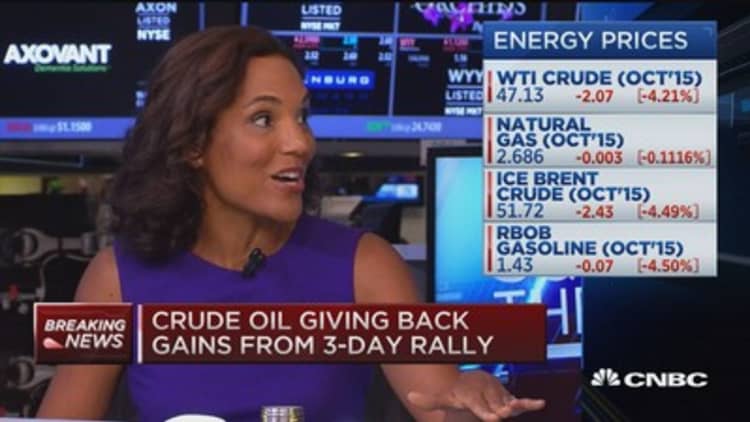Look out world—China's not the only central bank in town selling its currency reserves to cope with a tumultuous global economy.
With having shed more than half their value over the past year, oil producing economies are feeling the sting of cheaper oil. More importantly, Saudi Arabia—OPEC's largest member and the world's top oil producer—bears watching as oil stays below $50 and a global glut depresses oil prices, analysts say.
Even before China surprised markets by announcing a record drawdown of its foreign currency denominated assets, Saudi Arabia had already begun selling its reserves to plug a hole in its budget and support its flagging currency, the riyal. In February and March, the world's largest oil exporter saw net foreign assets drop by more than $30 billion, the biggest two- month drop on record.
Read More Fresh concerns after China's forex reserves drop
These asset sales are important because Saudi holds one of the world's largest reserve caches—and such sales put downward pressure on the and upward pressure on Treasury bond rates.
"The drop in oil prices, more so than volatility per se, have contributed to a decline in oil exporters' reserves globally," said Rachel Ziemba, senior director of emerging markets research at Roubini Global Economics, including members of the Gulf Cooperation Council (GCC) and other Middle East economies.
"Across the 11 oil exporters I track, reserves fell by over $200 billion over the last year," she added, even adjusting for changes in other FX holdings such as euros. According to Ziemba, Libya, Algeria and Iraq are also likely to eventually sell some FX assets, as are Bahrain and Oman. Wealthier Gulf nations have sizable FX assets, thus allowing them more time.
Nearly $700 billion to spend
Oil's continued slide and China's cloudy growth prospects have added even more downside risks to the outlook of Middle East oil producers, many of which are already reeling from conflict and terrorism. In particular, Saudi Arabia and China have forged closer bilateral ties in recent years, shaped by China's voracious energy needs. Within the last few years, the Saudis have become the biggest supplier of crude for the world's second largest economy.
According to analysts, Riyadh has sold off about $60 billion in the last 10 months alone, mainly to finance new spending and to support the peg. Still, the kingdom still maintains more than $650 billion in reserves, according to International Monetary Fund data.
Ziemba says Saudi asset sales have been devoted to propping up the riyal and public spending, but she added that Riyadh has repatriated some of its foreign currency deposits and placed them as deposits in local banks. That encourages those institutions to continue to lend and to shore up domestic liquidity.

The use of FX reserves, however, has been no panacea for Saudi Arabia's macroeconomic woes. In August, ratings agency Fitch revised the outlook for the kingdom to "negative" citing Saudi Arabia's "absence of an effective fiscal policy response to the lower oil price environment."
The country is still coping with growing deficits, which analysts say may lead to a currency devaluation. For now, Saudi Arabia has said it's committed to keeping the 3-decade-old currency peg in place, but that may not last if oil's slide deepens below $40 per barrel, as a few market watchers warn could happen.
"We think [riyal] devaluation is not imminent, though further delays to fiscal reforms could heighten perceptions of risk around the sustainability of the fiscal path, the credibility of the peg as well as undermine sovereign creditworthiness in the medium term as debt build-up accelerates," Barclays wrote in a recent research note.
However, "without adjustment to the current fiscal path, and if oil prices persist at $50 per barrel, Saudi Arabia could use up its financial buffers by 2019," the bank added.
Meanwhile, lower oil prices mean that sovereign funds have less capital to invest but for the moment, only a few countries such as Qatar and Kuwait are still receiving new capital, according to Roubini research data.
Even with oil's swoon creating ripple effects, few analysts expect Saudi Arabia to cut production.
"Macroeconomic factors should not be construed as a short-term determinant for Saudi oil policies," Barclays wrote, adding that it does not "expect the Kingdom to reduce output much below 10 mb/d in 2015 and 2016."


